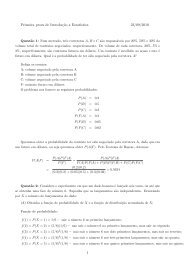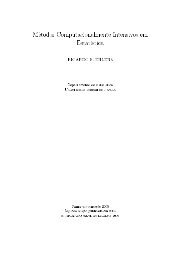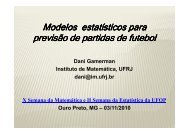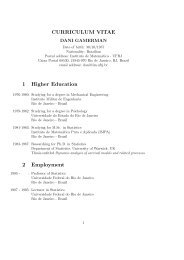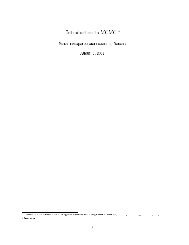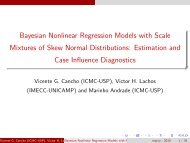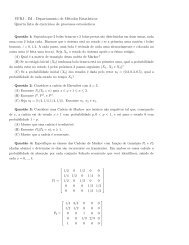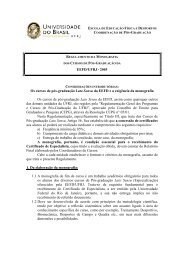Copulas: a Review and Recent Developments (2007)
Copulas: a Review and Recent Developments (2007)
Copulas: a Review and Recent Developments (2007)
Create successful ePaper yourself
Turn your PDF publications into a flip-book with our unique Google optimized e-Paper software.
Z¾ C;à (s) =dC(F X1 (x 1 );::: ;F Xn (x n ));fÃ(X 1 ;::: ;X n )·sg½ C;à (s) =inf¡ ¡x 1 ;::: ;x n¡1 2(¡1;1) Cdual F X1 (x 1 );::: ;F Xn¡1 (x n¡1 );F Xn á1n¡1 (s)¢¢ ;where à n¡1(s) ¡1 is the left continuous (generalized) inverse function of à n¡1 (s).Theorem (best possible bounds, Embrechts et al. (2003a)). Under the abovenotations if a copula C associated to (X 1 ;:::;X n ) satis¯es C ¸ C 0 <strong>and</strong> C dual · C1dualfor some given n-copulas C 0 <strong>and</strong> C 1 , then¿ C0 ;Ã(s) · ¾ C;à (s) · ½ C1 ;Ã(s):Note that, ¾ C;à (s) =P (Ã(X 1 ;:::;X n ) · s) =¤ à (s). Also, the bounds ¿ C0 ;Ã(s)<strong>and</strong> ½ C1 ;Ã(s) are themselves distribution functions. Since there is not necessarily aunique copula satisfying the inequalities in the last theorem, it is assumed additionallythat there exists a copula C such that C ¸ C 0 <strong>and</strong> C dual · C1 dual . The copulas C 0<strong>and</strong> C 1 represent the partial information available about the dependence structure of(X 1 ;:::;X n ). In Embrechts et al. (2003b) is proposed a methodology in order to ¯ndthe bounds for VaR p (¤ à (s)), recently re¯ned by Embrechts <strong>and</strong> Puccetti (2006).In most cases, the bounds in last theorem does not have closed form. In general,one has to use numerical approximations as proposed by Williamson <strong>and</strong> Downs(1990). Their algorithm is based on the discretization of ¿ C0 ;Ã(s), ½ C1 ;Ã(s) <strong>and</strong>onaduality principle due to Frank et al. (1987).Some problems related to the control <strong>and</strong> optimization of VaRin a portfolio withnon-normal or non-log-normal returns have taken the researchers to look for anotherquantile measures. Such a measure is called Tail Value-at-Risk at level p, <strong>and</strong>isde¯ned byZ 1TVaR p (X) = 1 VaR p (X)dq; p 2 (0; 1):1 ¡ p pIt is the arithmetic average of the VaR p (X), from p on. Therefore, TVaRis a measureof risk more suitable than VaR because it takes into account the losses beyond theVaR level. Note that always TVaR p (X) > VaR p (X), TVaR 0 (X) = E(X) <strong>and</strong>TVaR p (X) is a non-decreasing function of p. The fundamental di®erences betweenVaR<strong>and</strong> TVaR canbesummarizedasfollows: VaRis the \optimistic" lower boundof the tail loses <strong>and</strong> the TVaR is the expected value of tail losses. Therefore, TVaRcan be interpreted as a \conservative" risk measure.Rockfellar <strong>and</strong> Uryasev (2000, 2002) use CV aR instead of TVaR <strong>and</strong> provide analternative de¯nition of CV aR as a coherent measure (i.e. satisfy the sub-additivity,monotonicity, homogeneity <strong>and</strong> translation invariance axioms, see Artzner et al.18¥




